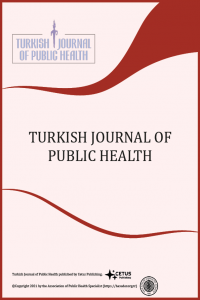COVID-19 pandemisi döneminde alınan önlemlerin hava kirliliğine etkisi Türkiye/Doğu Akdeniz örneği
Hava kirliliği, partiküler madde, COVID-19, pandemi, karbonmonoksit
The effect of measures taken during the COVID-19 pandemic on air pollution: A East Mediterranean example from Turkey
Air pollution, COVID-19 Air pollution, particulate matter, COVID-19, pandemics, carbon monoxide,
___
- Kemp AC, Horton BP, Donnelly JP, Mann ME, Vermeer M, Rahmstorf S. Climate related sea-level variations over the past two millennia. Proc Natl Acad Sci USA. 2011;108(27):11017-22.
- Song Y, Qin S, Qu J, Liu F. The forecasting research of early warning systems for atmospheric pollutants: A case in Yangtze River Delta region. Atmospheric Environment. 2015;118:58–69.
- Kumar A, Goyal P. Forecasting of daily air quality index in Delhi. Sci Total Environ. 2011;409(24):5517-23.
- Wang J, Jiang H, Zhou Q, Wu J, Qin S. China’s natural gas production and consumption analysis based on the multicycle Hubbert model and rolling Grey model. Renewable and Sustainable Energy Reviews. 2016;53:1149–67. https://sim.csb.gov.tr/STN/STN_Report/StationDataDownloadNew
- Mitreski, K., Toceva, M., Koteli, N., & Karajanovski, L. (2016). Air quality pollution from traffic and point sources in Skopje assessed with different air pollution models. Journal of Environmental Protection and Ecology, 17(3), 840-850.
- Schulz H, Karrasch S, Bölke G, Cyrys J, Hornberg C, Pickford R, Schneider A, Witt C, Hoffmann B. Atmen: Luftschadstoffe und Gesundheit – Teil II [Breathing: Ambient Air Pollution and Health - Part II]. Pneumologie. 2019;73(6):347-373. https://www.who.int/health-topics/air-pollution#tab=tab_2
- Wilder-Smith A, Freedman DO. Isolation, quarantine, social distancing and community containment: pivotal role for old-style public health measures in the novel coronavirus (2019-nCoV) outbreak. J Travel Med. 2020;27(2):taaa020.
- Dutheil F, Baker JS, Navel V. COVID-19 as a factor influencing air pollution? Environ Pollut. 2020;263(Pt A):114466.
- Kerimray A, Baimatova N, Ibragimova OP, et al. Assessing air quality changes in large cities during COVID-19 lockdowns: The impacts of traffic-free urban conditions in Almaty, Kazakhstan. Sci Total Environ. 2020;730:139179.
- Wang Y, Xue Q. The implications of COVID-19 in the ambient environment and psychological conditions. NanoImpact. 2021 Jan;21:100295.
- Rodríguez-Urrego D, Rodríguez-Urrego L. Air quality during the COVID-19: PM2.5 analysis in the 50 most polluted capital cities in the world. Environ Pollut. 2020 Nov;266(Pt 1):115042.
- Lokhandwala S, Gautam P. Indirect impact of COVID-19 on environment: A brief study in Indian context. Environ Res. 2020 Sep;188:109807.
- ESA, 2020b. Air Pollution Remains Low as Europeans Stay at Home. http://www.esa.int/ Applications/Observing_the_Earth/Copernicus/Sentinel-5P/Air_pollution_remains_lo w_as_Europeans_stay_at_home
- Paital B. Nurture to nature via COVID-19, a self-regenerating environmental strategy of environment in global context. Sci Total Environ. 2020 Aug 10;729:139088.
- Kanniah KD, Kamarul Zaman NAF, Kaskaoutis DG, Latif MT. COVID-19’s impact on the atmospheric environment in the Southeast Asia region. Sci Total Environ. 2020 Sep 20;736:139658.
- Shehzad K, Sarfraz M, Shah SGM. The impact of COVID-19 as a necessary evil on air pollution in India during the lockdown. Environ Pollut. 2020 Nov;266(Pt 1):115080.
- Berman JD, Ebisu K. Changes in U.S. air pollution during the COVID-19 pandemic. Sci Total Environ. 2020 Oct 15;739:139864.
- Baldasano JM. COVID-19 lockdown effects on air quality by NO2 in the cities of Barcelona and Madrid (Spain). Sci Total Environ. 2020 Nov 1;741:140353
- Zambrano-Monserrate MA, Ruano MA, Sanchez-Alcalde L. Indirect effects of COVID-19 on the environment. Sci Total Environ. 2020 Aug 1;728:138813.
- Bao R, Zhang A. Does lockdown reduce air pollution? Evidence from 44 cities in northern China. Sci Total Environ. 2020 Aug 20;731:139052.
- Kemp AC, Horton BP, Donnelly JP, Mann ME, Vermeer M, Rahmstorf S. Climate related sea-level variations over the past two millennia. Proc Natl Acad Sci USA. 2011;108(27):11017-22.
- Song Y, Qin S, Qu J, Liu F. The forecasting research of early warning systems for atmospheric pollutants: A case in Yangtze River Delta region. Atmospheric Environment; 2015;118:58–69.
- Kumar A, Goyal P. Forecasting of daily air quality index in Delhi. Sci Total Environ. 2011;409(24):5517-23.
- Wang P, Chen K, Zhu S, Wang P, Zhang H. Severe air pollution events not avoided by reduced anthropogenic activities during COVID-19 outbreak. Resour Conserv Recycl. 2020;158:104814.
- Başlangıç: 2003
- Yayıncı: Halk Sağlığı Uzmanları Derneği
Nesrin YAĞCI, Şule ŞİMŞEK, Aybike ŞENEL
Aile sağlığı merkezleri kuruluş yeri değerlendirmesi; metropol ilçe örneği
COVID-19 pandemisi döneminde alınan önlemlerin hava kirliliğine etkisi Türkiye/Doğu Akdeniz örneği
Burak METE, Onur ACAR, Ceren KANAT, Esra DOĞAN
Türkiye’de bir üçüncü basamak hastanede sağlık çalışanlarında SARS-CoV-2 seroprevalansı
Erhan ESER, Sebnem SENOL, Sinem AKÇALI, Talat ECEMİŞ, Pınar DÜNDAR, Kübra ÇİÇEK, Damla AKMAN, Ecem TÜZÜN, Gülsüm ŞANLI ERKEKOĞLU, Zeynep BURAN, Zeynep ÖZTÜRK, Ferya KARADAĞ
Selva Dilan GÖLBAŞI, Selma METİNTAS, Muhammed Fatih ÖNSÜZ
Aşılayıcılar için yeni bir eğitim yaklaşımı: İyileştirilmiş kademeli eğitim
Nurcan ALTAŞ, Zeynep ÇUKUROVA, Erdem Veli UZUN
İstanbul ili Silivri ilçesi lise öğrencilerinde depresyon sıklığı ve ilişkili risk faktörleri
